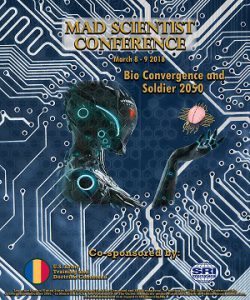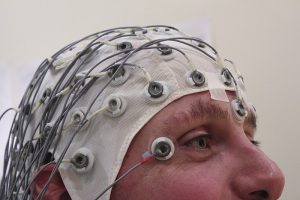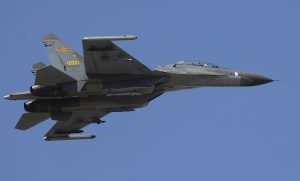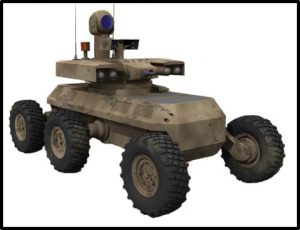[Editor’s Note: Mad Scientist Laboratory is pleased to present a post by Mad Scientist and guest blogger Lt Col Jennifer “JJ” Snow, addressing the emergence of a post-internet world.]
“The Internet of the 1990s was about choosing your own adventure. The Internet of right now, over the last 10 years, is about somebody else choosing your adventure for you.” – Cindy Cohn, Executive Director of the Electronic Frontier Foundation
 The internet was designed in its earliest iteration to provide a new form of communication, a way for people to connect, to share information in real-time, to provide a positive tool for collaboration and learning. Looking back at those early ideas, many of the founding fathers of the internet express disappointment in what it has become: a place where privacy and people are abused, information is wielded like a weapon, nations and corporations alike
The internet was designed in its earliest iteration to provide a new form of communication, a way for people to connect, to share information in real-time, to provide a positive tool for collaboration and learning. Looking back at those early ideas, many of the founding fathers of the internet express disappointment in what it has become: a place where privacy and people are abused, information is wielded like a weapon, nations and corporations alike  battle each other and other nefarious actors in the digital shadows, and fake news dominates the taglines in hopes of grabbing the most dollars per click. In light of what technologists, ethical hackers, and the public view as a potentially irrecoverable situation, many are suggesting starting over and abandoning the internet as we know it in favor of alternative internet options or “Alternet.” [1]
battle each other and other nefarious actors in the digital shadows, and fake news dominates the taglines in hopes of grabbing the most dollars per click. In light of what technologists, ethical hackers, and the public view as a potentially irrecoverable situation, many are suggesting starting over and abandoning the internet as we know it in favor of alternative internet options or “Alternet.” [1]
 These initiatives are nascent but are increasingly gaining traction as they offer users the option to manage their own identity and information online; choose what they do and don’t want to share digitally; provide transparency as a currency, meaning users can view rules, policies, and protocols openly at any time and see when changes are made real-time; and allow users to be their own data authority. While progress in this space will be slow but steady over the next two years, expect that “Alternets” will become a publicly recognized substitute to the big internet companies in five years and a commonplace feature of the web in 10 years as users become more disenchanted, distrustful, and decide they want greater control, attribution, or anonymity as needed, and desire an internet that meets their norms, cultural, and community preferences.
These initiatives are nascent but are increasingly gaining traction as they offer users the option to manage their own identity and information online; choose what they do and don’t want to share digitally; provide transparency as a currency, meaning users can view rules, policies, and protocols openly at any time and see when changes are made real-time; and allow users to be their own data authority. While progress in this space will be slow but steady over the next two years, expect that “Alternets” will become a publicly recognized substitute to the big internet companies in five years and a commonplace feature of the web in 10 years as users become more disenchanted, distrustful, and decide they want greater control, attribution, or anonymity as needed, and desire an internet that meets their norms, cultural, and community preferences.
There are several interesting challenges that come with the fracturing of the internet in this manner.
 First, Alternets will be more insular, require individual verification to join, and users will need to buy special equipment like a community specific encrypted router or use a particular variant of the blockchain to access the web.
First, Alternets will be more insular, require individual verification to join, and users will need to buy special equipment like a community specific encrypted router or use a particular variant of the blockchain to access the web.
 Secondly, Alternets may serve to fracture the internet itself in interesting ways that could impact how data and users are able to digitally traverse the globe.
Secondly, Alternets may serve to fracture the internet itself in interesting ways that could impact how data and users are able to digitally traverse the globe.
 Third, Alternets will provide both the attribution many desire in social media to stop cyber bullying, scammers, and fake news, and the anonymity features that allow both dissident and terror groups to operate safely in virtual spaces. As with all technologies, there will always be opportunities for both positive and malicious use.
Third, Alternets will provide both the attribution many desire in social media to stop cyber bullying, scammers, and fake news, and the anonymity features that allow both dissident and terror groups to operate safely in virtual spaces. As with all technologies, there will always be opportunities for both positive and malicious use.
 Fourth, the development and spread of Alternets may serve to further polarize various interests, organizations, and nations as like-minded communities will group together rather than strive to engage in constructive discourse, further reducing the opportunity for bridging entities to be effective negotiators.
Fourth, the development and spread of Alternets may serve to further polarize various interests, organizations, and nations as like-minded communities will group together rather than strive to engage in constructive discourse, further reducing the opportunity for bridging entities to be effective negotiators.
 Fifth, such online fracturing may also manifest physically in real life leading to conflict, both digital and physical, and may enhance the weaponization of cyber in new ways to include citizen cyber militia actively operating in defense of their communities and/or their nation or offensive attacks by nations operating from their own “Alternet” separate from the existing DNS system and not regulated and not easily targetable by competitor nations, thus limiting their ability to counterstrike and creating an overmatch situation. [2]
Fifth, such online fracturing may also manifest physically in real life leading to conflict, both digital and physical, and may enhance the weaponization of cyber in new ways to include citizen cyber militia actively operating in defense of their communities and/or their nation or offensive attacks by nations operating from their own “Alternet” separate from the existing DNS system and not regulated and not easily targetable by competitor nations, thus limiting their ability to counterstrike and creating an overmatch situation. [2]
 Current examples of “Alternets” that exist today include the private citizen efforts of the Metacurrency Project called Holo; the Russian independent internet for the BRICS block of nations; the PRC alternative which has also been installed in Tanzania, Nigeria, and Vietnam; BitDust, a decentralized, encrypted, anonymous storage and communication solution; Mastodon a decentralized, personally hosted, microblogging solution used in the Middle East, Africa, and Asia; and Hyperboria which was born out of the DarkNet and is an encrypted, distributed, peer-to-peer IPv6 network with Distributed Hash Table (DHT)-based source routing.
Current examples of “Alternets” that exist today include the private citizen efforts of the Metacurrency Project called Holo; the Russian independent internet for the BRICS block of nations; the PRC alternative which has also been installed in Tanzania, Nigeria, and Vietnam; BitDust, a decentralized, encrypted, anonymous storage and communication solution; Mastodon a decentralized, personally hosted, microblogging solution used in the Middle East, Africa, and Asia; and Hyperboria which was born out of the DarkNet and is an encrypted, distributed, peer-to-peer IPv6 network with Distributed Hash Table (DHT)-based source routing.
A full listing of “Alternet” projects and tools can be found in the footnotes. [3]
To learn more about the security ramifications associated with the rise of Alternets, read the following blog posts:
– The Future of the Cyber Domain
– Virtual Nations: An Emerging Supranational Cyber Trend, by Marie Murphy
JJ Snow is an Air Force Lt Colonel assigned as the U.S. Special Operations Command Innovation Officer and the J5 Donovan Group Future Plans and Strategy Deputy Director. In her current role, JJ serves as the government representative for technology outreach and engagement on behalf of the command and 756 interagency action officers spanning 40 different government agencies.
She is responsible for maintaining a network of non-traditional experts across industry, academia and ethical hackers/technologists to provide government with critical access, expertise and capacity across a broad spectrum of technologies to rapidly identify best of breed while also proactively responding to potential threat aspects of concern to Special Operations and national security. She supports senior government leadership in process innovation, innovation planning in big government, and the development of smart technology policy and advises senior government representatives on emerging disruptive technologies.
She holds a MS Degree in Defense Analysis with distinction from the Naval Postgraduate School (NPS) and a MA from American Military University in Strategic Intelligence with honors.
[1] Saldana et al., “Alternative Networks: Toward Global Access to the Internet for All.” IEEE Communications Magazine, vol. 55, no. 9, pp. 187-193, 2017.
Lafrance, Adrienne; “The Promise of a New Internet.” The Atlantic (10 JUN 2014)
Finley, Klint; “The Pied Piper’s New Internet Isn’t Just Possible – It’s Almost Here.” Wired (1 JUN 2017)
[2] Eric Harris-Braun, Nicolas Luck, Arthur Brock; “Holochain: Scalable Agent-Centric Distributed Computing.” Holo (15 FEB 2018)
Degurin, Mack; “Russia’s Alternate Internet.” NY Magazine (13 JUL 2018)
Sacks, Sam; “Beijing Wants to Rewrite the Rules of the Internet.” The Atlantic (18 JUN 2018)
[3] The following links are included to provide the reader with the options of exploring some additional alternative internet options that exist and are in use today. A big thank you to Ross Jones in recognition for his detailed GitHub Wiki on this subject which is captured in the last link concerning alternative-internet solutions and tools: https://hyperboria.net/, https://github.com/redecentralize/alternative-internet



 [Editor’s Note: The United States Army Training and Doctrine Command (TRADOC) co-hosted the Mad Scientist Bio Convergence and Soldier 2050 Conference with SRI International at their Menlo Park, CA, campus on 8-9 March 2018, where participants discussed the advent of new biotechnologies and the associated benefits, vulnerabilities, and ethics associated with Soldier enhancement for the Army of the Future. The following post is an excerpt from this conference’s final report.]
[Editor’s Note: The United States Army Training and Doctrine Command (TRADOC) co-hosted the Mad Scientist Bio Convergence and Soldier 2050 Conference with SRI International at their Menlo Park, CA, campus on 8-9 March 2018, where participants discussed the advent of new biotechnologies and the associated benefits, vulnerabilities, and ethics associated with Soldier enhancement for the Army of the Future. The following post is an excerpt from this conference’s final report.]

 Cognitive enhancement could make Soldiers more lethal, more decisive, and perhaps more resilient. Using neurofeedback, a process that allows a user to see their brain activity in real-time, one can identify ideal brain states, and use them to enhance an individual’s mental performance. Through the mapping and presentation of identified expert brains, novices can rapidly improve their acuity after just a few training sessions.
Cognitive enhancement could make Soldiers more lethal, more decisive, and perhaps more resilient. Using neurofeedback, a process that allows a user to see their brain activity in real-time, one can identify ideal brain states, and use them to enhance an individual’s mental performance. Through the mapping and presentation of identified expert brains, novices can rapidly improve their acuity after just a few training sessions.
 However, a host of new vulnerabilities, at the genetic level, accompany this revolutionary leap in human evolution. If one can map the human genome and more thoroughly scan and understand the brain, they can target genomes and brains in the same ways. Soldiers could become incredibly vulnerable at the genomic level, forcing the Army to not only protect Soldiers using body armor and armored vehicles, but also protect their identities, genomes, and physiologies.
However, a host of new vulnerabilities, at the genetic level, accompany this revolutionary leap in human evolution. If one can map the human genome and more thoroughly scan and understand the brain, they can target genomes and brains in the same ways. Soldiers could become incredibly vulnerable at the genomic level, forcing the Army to not only protect Soldiers using body armor and armored vehicles, but also protect their identities, genomes, and physiologies. Adversaries will exploit all biological enhancements to gain competitive advantage over U.S. forces. Targeted genome editing technology such as CRISPR will enable adversarial threats to employ super-empowered Soldiers on the battlefield and target specific populations with bioweapons. U.S. adversaries may use technologies recklessly to achieve short term gains with no consideration of long range effects.
Adversaries will exploit all biological enhancements to gain competitive advantage over U.S. forces. Targeted genome editing technology such as CRISPR will enable adversarial threats to employ super-empowered Soldiers on the battlefield and target specific populations with bioweapons. U.S. adversaries may use technologies recklessly to achieve short term gains with no consideration of long range effects.
 Another consideration is whether or not the Soldier enhancements are permanent. By enhancing Soldiers’ faculties, the Army is, in fact, enhancing their lethality or their ability to defeat the enemy. What happens with these enhancements—whether the Army can or should remove them— when a Soldier leaves the Army is an open question. As stated previously, the Army is willing and able to improve eyesight, but does not revert that eyesight back to its original state after the individual has separated. Some possible moral questions surrounding Soldier enhancement include:
Another consideration is whether or not the Soldier enhancements are permanent. By enhancing Soldiers’ faculties, the Army is, in fact, enhancing their lethality or their ability to defeat the enemy. What happens with these enhancements—whether the Army can or should remove them— when a Soldier leaves the Army is an open question. As stated previously, the Army is willing and able to improve eyesight, but does not revert that eyesight back to its original state after the individual has separated. Some possible moral questions surrounding Soldier enhancement include: • If the Army were to increase a Soldier’s stamina, visual acuity, resistance to disease, and pain tolerance, making them a more lethal warfighter, is it incumbent upon the Army to remove those enhancements?
• If the Army were to increase a Soldier’s stamina, visual acuity, resistance to disease, and pain tolerance, making them a more lethal warfighter, is it incumbent upon the Army to remove those enhancements?

 If China were to succeed in realizing the full potential of quantum technology, the Chinese People’s Liberation Army (PLA) might have the capability to offset core pillars of U.S. military power on the future battlefield. Let’s imagine the worst-case (or, for China, best-case) scenarios.
If China were to succeed in realizing the full potential of quantum technology, the Chinese People’s Liberation Army (PLA) might have the capability to offset core pillars of U.S. military power on the future battlefield. Let’s imagine the worst-case (or, for China, best-case) scenarios.
 Although there will be options available for ‘quantum-proof’ encryption, the use of public key cryptography could remain prevalent in older military and government information systems, such as legacy satellites. Moreover, any data previously collected while encrypted could be rapidly decrypted and exploited, exposing perhaps decades of sensitive information. Will the U.S. military and government take this potential security threat seriously enough to start the transition to quantum-resistant alternatives?
Although there will be options available for ‘quantum-proof’ encryption, the use of public key cryptography could remain prevalent in older military and government information systems, such as legacy satellites. Moreover, any data previously collected while encrypted could be rapidly decrypted and exploited, exposing perhaps decades of sensitive information. Will the U.S. military and government take this potential security threat seriously enough to start the transition to quantum-resistant alternatives?

 At present, quantum computing, while approaching the symbolic milestone of “quantum supremacy,” faces a long road ahead, due to challenges of scaling and error correction.
At present, quantum computing, while approaching the symbolic milestone of “quantum supremacy,” faces a long road ahead, due to challenges of scaling and error correction.
 As China challenges American leadership in
As China challenges American leadership in




 Realizing that algorithms supporting future Intelligence, Surveillance, and Reconnaissance (ISR) networks and Commander’s decision support aids will have inherent biases — what is the impact on future warfighting? This question is exceptionally relevant as Soldiers and Leaders consider the influence of biases in man-machine relationships, and their potential ramifications on the battlefield, especially with regard to the rules of engagement (i.e., mission execution and combat efficiency versus the proportional use of force and minimizing civilian casualties and collateral damage).
Realizing that algorithms supporting future Intelligence, Surveillance, and Reconnaissance (ISR) networks and Commander’s decision support aids will have inherent biases — what is the impact on future warfighting? This question is exceptionally relevant as Soldiers and Leaders consider the influence of biases in man-machine relationships, and their potential ramifications on the battlefield, especially with regard to the rules of engagement (i.e., mission execution and combat efficiency versus the proportional use of force and minimizing civilian casualties and collateral damage). The Mad Scientist Initiative has developed a series of questions to help frame the discussion regarding what biases we are willing to accept and in what cases they will be acceptable. Feel free to share your observations and questions in the comments section of this blog post (below) or email them to us at: usarmy.jble.tradoc.mbx.army-mad-scientist@mail.mil.
The Mad Scientist Initiative has developed a series of questions to help frame the discussion regarding what biases we are willing to accept and in what cases they will be acceptable. Feel free to share your observations and questions in the comments section of this blog post (below) or email them to us at: usarmy.jble.tradoc.mbx.army-mad-scientist@mail.mil. 2) In what types of systems will we accept biases? Will machine learning applications in supposedly non-lethal warfighting functions like sustainment, protection, and intelligence be given more leeway with regards to bias?
2) In what types of systems will we accept biases? Will machine learning applications in supposedly non-lethal warfighting functions like sustainment, protection, and intelligence be given more leeway with regards to bias? 4) At what point will the pace of innovation and introduction of this technology on the battlefield by our adversaries cause us to forego concerns of bias and rapidly field systems to gain a decisive Observe, Orient, Decide, and Act (OODA) loop and combat speed advantage on the
4) At what point will the pace of innovation and introduction of this technology on the battlefield by our adversaries cause us to forego concerns of bias and rapidly field systems to gain a decisive Observe, Orient, Decide, and Act (OODA) loop and combat speed advantage on the